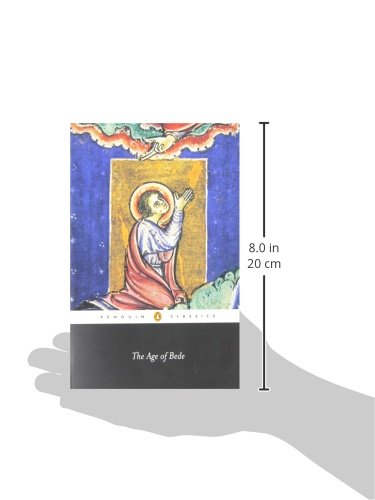Customer Services
Copyright © 2025 Desertcart Holdings Limited
Desert Online General Trading LLC
Dubai, United Arab Emirates




The Age of Bede (Penguin Classics)
J**S
"A Fascinating Read"
This edition is comprised of the venerable Bede's "Life of Cuthbert" and the "Lives of the Abbots of Wearmouth and Jarrow; the priest Eddius Stephanus' "Life of Wilfrid;" and also included is the "Voyage of St Brendan" and the "History of Abbot Ceolfrith." These works brim with saintly tails of healings and exorcisms, and of prophecies and portents. These books contain some interesting historical information as well: such as the spread of Christianity on the British Isles during the sixth and seventh centuries. The introduction provides both a comprehensive look at the individuals who wrote these books and a general picture of they age they lived in. These books will no doubt be a fascinating read for anyone interested in the history of Christianity in Britain, or just in good simple hagiography.
A**L
Five Stars
Anyone interested in early medieval England should own this book. Includes several classics of Anglo-Saxon literature.
A**R
Four Stars
Nice but not what I needed
Z**E
Five Stars
Essential reading for any student of early Mediaeval English History
B**O
Five Stars
was inspired to read this by a trip to England
D**N
in fine shape and in a timely manner
This item is as described. The price was quite reasonable. The book arrived safely packed, in fine shape and in a timely manner. Very satisfied.
F**R
Really good. Excellent
Really good. Excellent
I**R
Ian Myles Slater on: The Latest Incarnation
This Penguin Classics volume had a somewhat complicated history, even before it was digitized for Kindle. Those who are familiar with earlier editions, and wondering whether to bother with the new one, or are not familiar with it at all, and are considering a used print copy, should be aware of the differences.It began as a shorter (206 page) Penguin Classics volume called (a little grandly) "Lives of the Saints," published in 1965. This version, edited and translated by J.F. Webb, contained the anonymous *The Voyage of Saint Brendan,* Bede's *Life of Cuthbert* (from the prose version), and the *Life of Wilfrid,* by Eddius Stephanus.The first, the "Navigatio," is a legendary account of the supposed sea voyages of an actual Irish abbot, and was one of the most popular works of the Middle Ages.The Venerable Bede's account of St. Cuthbert was commissioned by a monastic community devoted to his memory, and is based mainly on an earlier anonymous "Life," which Bede himself had earlier adapted in verse, and had drawn on for a much less miraculous account of its hero in his "History of the English Church and People" (or, "Ecclesiastical History"). This complicated redaction history is not unusual, but for once we know that three of the versions came from the same hand.The "Life of Wilfrid" is a partisan account, by one of his followers, of a Northumbrian bishop who somehow managed to have almost as many disputes with his friends as with his enemies. (Bede also deals with Wilfrid in his "History," with considerably less enthusiasm than Eddius shows.)This version had considerable internal coherence, as it illustrated the variety of literature found under the heading of "Lives of the Saints," and various roles as edifying entertainment, institutional piety, and partisan propaganda. The three texts are also roughly contemporary, and, as should be clear, reflect Irish and British traditions of hagiography, directly or as adopted by the Anglo-Saxons. It was reprinted through at least the mid-1970s (I had a copy from 1975). The quality of the translations of all three is high, although some readers initially entertained by Brendan's symbol-laden adventures in a visionary North Atlantic were probably let down by the increasingly terrestrial and political tone of the remainder."The Voyage of St. Brendan" (not to be confused with the Latin and Middle Irish "Lives" of this saint) is connected to a larger body of secular accounts of fantastic sea voyages from medieval Ireland (Maelduin, Bran, and others, some no longer extant). It is not clear which Irish tradition influenced the other, however. Bits and pieces of the Brendan version seem credible, but their connection with him may be as much an invention as the psalm-singing birds and terrestrial paradises he and his monks are said to encounter. Since the other Irish voyage stories (*immrama*) seem to have been unknown elsewhere, and the Latin "Voyage" was both copied and translated throughout Europe, it should be credited with a major role in making Irish literary motifs a part of the European tradition.It probably is in the background of William Morris' story of voyages to marvelous islands, "The Water of the Wondrous Isles" (1895), very likely of the quest in "The Glittering Plain" (1891) and possibly of the setting of his "The Earthly Paradise" (1868-70). The "Navigatio" was certainly known to C.S. Lewis when he wrote "The Voyage of the Dawn Treader." Tolkien even wrote (and re-wrote) a poem about Brendan, so it is safe to conclude that the "Voyage" contributed something to "The Silmarillion," if not "Lord of the Rings."(Two versions can be found in the "History of Middle-earth" Volume IX, "Sauron Defeated" as "The Death of St. Brendan" and "Imram" -- not included in the paperback, "The End of the Third Age" -- with a correction on page x of Volume X, "Morgoth's Ring." Thanks to Tolkien scholar David Bratman for pointing out that it had indeed been reprinted, and was no longer virtually unobtainable in a 1955 issue of a British magazine.)In 1983, the old "Lives of the Saints" was incorporated in "The Age of Bede," edited, with revisions and new translations, by D.H. Farmer.The new title fairly accurately reflected the time and locale of the texts, and ran to 256 pages, including maps and an index. "Brendan" was shifted to the end of the volume.Following the "Life of Wilfrid," Bede's *Lives of the Abbots of Wearmouth and Jarrow* was inserted. This last is based on the records and traditions of the dual monastic foundation of which Bede was a member.This expanded form of the collection displayed Bede as a more sober institutional historian, recording the accomplishments, piety, and good works of the leaders of his own community. "Lives" lacks the accumulation of miracles which had already become connected with Cuthbert. "The Voyage of Brendan" seems increasingly atypical in the expanded collection, and I suspect some readers never found their way to it, which would be a pity. This edition was somewhat revised in 1988.The current version -- the one now available in Kindle format -- appeared in 1998, and contained an additional work, the *Anonymous History of Abbot Ceolfrith,* inserted between "Lives of the Abbots" and "The Voyage of St. Brendan." Ceolfrith was Bede's own abbot, and this biography illustrates the difference between Bede's spare and sober account and what could happen when pious memory and oral tradition took over. It also has a revised introduction, and an updated bibliography. This brought the length to 278 pages.The 2004 printing of the 1998 edition of "The Age of Bede" is the source of the Kindle text, so anyone who has that edition probably doesn't need the Kindle version -- unless you want to add it to a portable library, or need to enlarge the type. The same may apply to the 1988 edition, although it is somewhat antiquated. The shorter "Lives of the Saints" is less than satisfactory, unless all you want is one of the three "lives."
L**E
It’s revised
It really is revised
Y**M
Yep its that book you think it is.
If you're expecting 'the age of Bede' this book is it top to bottom.
D**L
Five Stars
A very interesting read, adds to my understanding of the way we should relate to God.
S**N
Best thing in this is 'Voyage of Brendan'
Best thing in this is 'Voyage of Brendan', and it's totally surreal! 'Life of Cuthbert not bad, either, but St.Wilfred is so-so, likewise Abbots of Jarow.
T**7
New insights into Old Worlds
Wonderful book -only had a chance to dip into it as yet. Bede, Cuthbert and all the people included in this book are extraordinary people living in challenging times. We have much to learn.
Trustpilot
1 month ago
3 days ago